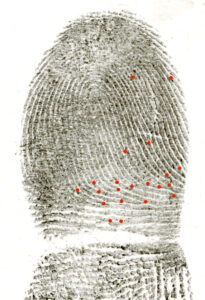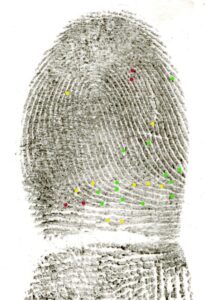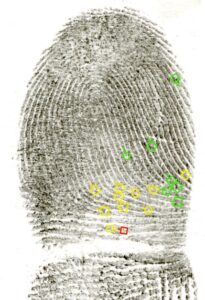
Published on August 9, 2019
Fingerprint annotations, sometimes called markups, have become very important in fingerprint analysis. The days when examiners peered into a fingerprint loupe and used picks or made mental notes on what they observed before comparing the latent print to the known record are gone. Today, most fingerprint analysis takes place on a computer monitor. Software is used to analyze and record important features within a print. The annotation records created by these software packages provide proof that a comprehensive analysis was undertaken in support of the ACE-V methodology (Analysis Comparison Evaluation and Verification) practiced by most latent fingerprint examiners.
When they are properly created, they can support subsequent processes and can also mitigate the various biases that can make the subsequent comparison and evaluation processes vulnerable to criticism. Unfortunately, often they are created during the comparison phase and not in advance of seeing the known fingerprint record. Sometimes they are created as an afterthought, even after the evaluation has been made – for Court purposes.
The 2012 paper, “Latent Print Examination and Human Factors: Improving the Practice through a Systems Approach” raises concerns about looking at the known fingerprint record before conducting a thorough analysis of the latent record. It identifies various biases that can affect human decision-making and value determinations. These potential problems are amplified when dealing with a latent print of marginal quality or where the evidence is determined to be a “complex case”.
Annotations are a crucial source of information and can either support an examiner’s claim of expertise or they can impeach an examiner as an expert. Whenever these annotations are undertaken or are made available, they should be scrutinized thoroughly.
Canadian police colleges have been teaching forensic students to document their analysis findings for a very long time. Despite that training, some police agencies balk at this important step citing time constraints and/or that they don’t think it is important enough. At the very least they should be created when the examiner recognizes that the latent print is marginal in quality or if the case is serious. In today’s forensic landscape it is expected that these annotations be provided, and clearly, they benefit everyone in the judicial process.
Fingerprint annotations or markups come in various formats.
The traditional fingerprint annotation places a colored dot (usually red) on features the examiner relied on.

Traditional Annotation
This system is inherently problematic.
- It treats all features as being equal when they may not be
- It does not identify the feature marked
- There is no indication of the clarity of the feature. This is important because friction ridge impressions are evaluated on a qualitative and quantitative basis.
- The marked feature may not exist on the known record.
- There is no way to know if a feature was discovered after the comparison with the known record was made. This invites potential confirmation bias that may alter the evaluation.
- This annotation system only valuates level two features (points). It does not address the value of the pattern (level one feature) and it does not attempt to address any highly discriminating level 3 features such as pores and edge features.
*Note: Most Canadian examiners cannot reliably valuate level one features or level three features.
A more progressive annotation approach uses the GYRO system developed by Dr. Glenn Langenburg and Dr. Christophe Champod. The system uses different colors (Green Yellow Red Orange) to attribute confidence with respect to the clarity. Features within a print are assigned a color which represents the level of clarity associated to the feature observed in the analysis phase. Sometimes the yellow features are marked in blue as it is easier to view on a monitor or in printed form. Green represents the highest confidence of the existence of a feature, yellow represents moderate confidence and red represents the lowest confidence with respect to clarity of the feature. The color orange is used to acknowledge that the feature was observed after the comparison was made. Consequently, the feature should then be given a lower weighted value.
One of the good things about the GYRO system is that it can also show the variability in clarity of a given print

GYRO Annotation – Level Two Features (Quantity)
Another good thing about the GYRO system is that it can also show the variability in the overall clarity of a given print using the same color-coded system.

GYRO Annotation – Level One Features (Clarity)
While the GYRO system annotations are better than the traditional system, they still suffer from deficiencies.
1) It treats all features as being equal when they may not be. It does however address the important issue of clarity in features.
2) The GYRO system also does not identify the marked features.
3) You still must refer to the known print to confirm the features existence.
Deficiencies aside, the system does address level one (ridge flow – pattern) and level two features (points) and there is a variant that attempts to address the presence of level three features (pores, edges).
The most progressive annotation systems use various symbols to denote the type of feature the examiner observes along with the colorization demonstrating the clarity level noted by the examiner. These symbols will replace the dots in the previous two examples.
Source: SWGFAST Document #8 Standard for the Documentation of Analysis, Comparison, Evaluation, and Verification (ACE-V) (Latent)


SWGFAST feature set with GYRO Annotation
This system does indeed identify the feature observed and it also addresses the issue of clarity. As with all fingerprint annotations, the known record should be checked for the presence of the feature that was marked.
A future variant may address the issue of features in a latent print that were not found in the known record.
There is another annotation system that is sometimes found in use in Canada. This system is occasionally used to support a fingerprint analysis. I find myself wondering why it is in use, particularly as an analysis tool. The system uses colored ridges to illustrate ridge features. Ordinarily, this system is used to support the comparison phase of ACE-V but I have seen it used in casework as an annotation system for the analysis of a print. The system appears to be rooted in Hale’s philosophy of friction ridges being islands and branches.

Colored Ridge Annotation
The first question I would ask of someone that presents this type of analysis annotation is, “what are you trying to articulate?” “What does this annotation tell us about this print?”
Does this system address value?
- It illustrates level one ridge flow which has some value, but I doubt the examiner presenting this annotation understands the value of this amount of level one detail.
Does this system help lay persons or other examiners understand the value within a given print?
- The short answer is no. Worse, there may be some ethical issues in using such a system. It appears that the colorization of the friction ridges has the effect of “gilding the lily” or making the print look better than it is. There are strict guidelines in image processing that are designed to prevent embellishment of images.
Does this system speak to the important features in fingerprints? Does it address the clarity spectrum?
Fingerprints are evaluated on a qualitative-quantitative basis. All features should be considered.
- Level one, the flow of the friction ridges aka. the patterns
- Level two features such as ridge endings, ridge dots and bifurcations
- Level three features, the pores, edge features and incipient detail in the furrows
This system does not address clarity at all. The only aspect of fingerprint analysis it may convey is the requirement of continuous agreement and that aspect is usually used in support of a comparison, not the analysis of a print.
The amount of analysis information available in this system would be grossly insufficient to speak to the value of any latent print and may disqualify any suggestion that the analysis portion of the ACE-V process was properly undertaken.
There are other annotation systems and software programs out there that attempt to facilitate the purpose of an annotation system. My experience with these systems tells me that these processes are still only as good as the fingerprint examiners using them.
Conclusion
The importance of fingerprint annotations cannot be understated. Without this valuable evidence an examiner has virtually no proof they undertook the analysis required as part of the ACE-V methodology. This evidentiary proof describes the features within a fingerprint on which the examiner relied on to support subsequent actions such as comparison and evaluations.
I would encourage any latent print examiners and all law enforcement agencies that use friction ridge evidence in support of their investigations to ensure fingerprint annotations are completed in each case. Supervisors should review this data before any disclosure is made. Doing so may shed some light on friction ridge analysis issues that may arise and afford the opportunity to address any issues discovered by offering their staff support through training and mentoring.
The bottom line is that whichever fingerprint markup system is used, the data provided by the examiner should be scrutinized for accuracy and validity. The annotation should always then be compared to the features found in the known record.
Shane Turnidge
www.sstforensics.com
